Analytical Model for Bond Behavior Prediction of CFRP-Concrete Joints with End Anchorage
Abstract
:1. Introduction
2. Theoretical Background to the Analytical Model
2.1. Basic Assumptions
- The interface bears only the tangential bonding stress, and no normal stress yields;
- CFRP and concrete are elastic, and the nonlinear mechanical characteristics including bond effect and failure only exist within the bond interface;
- Regardless of the thickness of adhesive, the bond effect and failure of the bonding interface are reflected in the interfacial bond-slip model;
- The CFRP stress is evenly distributed along the thickness direction, no considering the stress change in the width direction;
- The anchor end is fully anchored, and the CFRP sheet at the anchor position does not have any slide during the whole loading process.
2.2. Differential Equilibrium Equations
2.3. Interfacial Slip and Stress Solution
2.4. External Load—Slip Response
3. Interface Characteristics
3.1. Bond Failure Load
3.2. Effective Bond Length
4. Validation of the Presented Analytical Model
4.1. Experimental Program
4.2. Results of Comparisons
4.2.1. Load-Slip Response
4.2.2. Strain Distribution
4.2.3. Bond Failure Load and Slip
5. Conclusions
- The analytical solutions provide a series of expressions for the, including interfacial stress, CFRP strain, load-slip response, bond failure load and effective bond length, which are helpful for fully understanding the whole bond and debonding process of CFRP–concrete interfaces with end anchorage;
- A single-lap shear test has been conducted to validate the accuracy of the above analytical solutions. Based on two-parameter exponential bond-slip model, the analytical predictions had a good agreement with the experimental results, in the aspects of load-slip response, CFRP strain distribution and bond failure load. It is indicated that the presented analytical approach can predict well the bond performance of end anchored CFRP–concrete joints with different bond lengths.
- The load-slip behavior of end anchored CFRP–concrete joints could be divided into three branches: (i) Elastic stage, the tensile load has a nearly linear development; (ii) Stable stage, the plateau stage occurs approximately at the value of . As the increase of normalized bond length, the length of the plateau stage increases; (iii) Enhancement stage, the anchors play a major role in the stage. With the continued increase of slip, the slope of the curve tends to the axial tensile stiffness of CFRP.
- With the increase of bond length, bond failure load decreased firstly to a lower limit at ABL = 3 and then gradually increased to the ultimate value of .
- The CFRP–concrete joints with end anchorage need a larger effective bond length than the external bonded joints. The effective bond length for the end anchored joints shall be at least 7.2/AB.
Author Contributions
Funding
Institutional Review Board Statement
Informed Consent Statement
Data Availability Statement
Conflicts of Interest
Nomenclature
| width of concrete | |
| width of CFRP composite | |
| elastic modulus of concrete | |
| elastic modulus of CFRP composite | |
| bond length of CFRP-concrete joint | |
| effective bond length | |
| external tensile load at the load end | |
| anchor force at the anchor end | |
| bond force | |
| bond failure load | |
| anchoring force corresponding to the bond failure load | |
| bond force corresponding to the bond failure load | |
| s | slip or relative displacement between the CFRP and the concrete |
| slip corresponding to the bond failure load | |
| thickness of concrete | |
| thickness of CFRP composite | |
| displacement of the concrete | |
| displacement of CFRP composite | |
| ratio of anchor load to external load | |
| strain in the CFRP composite at the anchor end | |
| strain in concrete | |
| strain in the CFRP composite | |
| interfacial bond stress | |
| bond strength of CFRP-concrete Joint | |
| stress of the concrete | |
| stress of the CFRP composite |
References
- Hai, Y.Z.; Hao, R.V.; Venkatesh, K.; Shu, L.Q. Performance comparison of fiber sheet strengthened RC beams bonded with geo-polymer and epoxy resin under ambient and fire conditions. J. Struct. Fire Eng. 2018, 9, 174–188. [Google Scholar]
- Arash, R.; Farzad, H.; Ramin, V.; Mohd, S.J. Finite element development of a Beam-column connection with CFRP sheets subjected to monotonic and cyclic loading. Comput. Concr. 2016, 18, 1083–1096. [Google Scholar]
- Zhao, Q.; Zhao, J.; Dang, J.T.; Chen, J.W.; Shen, F.Q. Experimental investigation of shear walls using carbon fiber reinforced polymer bars under cyclic lateral loading. Eng. Struct. 2019, 191, 82–91. [Google Scholar] [CrossRef]
- Täljsten, B. Strengthening of concrete prisms using the plate-bonding technique. Int. J. Fract. 1996, 82, 253–266. [Google Scholar] [CrossRef]
- Arduini, M.; Di, T.A.; Nanni, A. Brittle failure in FRP plate and sheet bonded beams. ACI Struct. J. 1997, 94, 363–370. [Google Scholar]
- Teng, J.G.; Chen, J.F.; Smith, S.T.; Lam, L. FRP Strengthened RC Structures; Wiley: Chichester, UK, 2002. [Google Scholar]
- Dai, J.G.; Ueda, T.; Sato, Y. Unified analytical approaches for determining shear bond characteristics of FRP-concrete interfaces through pullout tests. J. Adv. Concr. Technol. 2006, 4, 133–145. [Google Scholar] [CrossRef] [Green Version]
- ACI. Guide for the Design and Construction of Externally Bonded FRP Systems for Strengthening Concrete Structures; ACI: Farmington Hills, MI, USA, 2017. [Google Scholar]
- Kalfat, R.; Al-Mahaidi, R.; Smith, S.T. Anchorage devices used to improve the performance of reinforced concrete beams retrofitted with FRP composites: State-of-the art review. J. Compos. Construct. 2011, 17, 14–33. [Google Scholar] [CrossRef]
- Grelle, S.V.; Sneed, L.H. Review of anchorage systems for externally bonded FRP laminates. Int. J. Concr. Struct. Mater. 2013, 7, 17–33. [Google Scholar] [CrossRef] [Green Version]
- Ariyansyah, R.; Gunadi, R.; Reski, I.A.; Rosanti, I. Enhancing the Performance of Reinforced Concrete Beam Structure Using CFRP and CFRP Anchor. IOP Conf. Ser. Earth Environ. Sci. 2021, 832, 012021. [Google Scholar] [CrossRef]
- Alaa, T.A.; Sergio, F.B. Strength of Carbon Fiber-Reinforced Polymer (CFRP) Sheets Bonded to Concrete with CFRP Spike Anchors. ACI Struct. J. 2021, 118, 153–166. [Google Scholar]
- Smith, S.T.; Hu, S.; Kim, S.J.; Seracino, R. FRP-strengthened RC slabs anchored with FRP anchors. Eng. Struct. 2011, 33, 1075–1087. [Google Scholar] [CrossRef]
- Wu, Y.; Huang, Y. Hybrid bonding of FRP to reinforced concrete structures. Compos. Construct. 2008, 12, 266–373. [Google Scholar] [CrossRef]
- Wu, Y.F.; Wang, Z.; Liu, K.; He, W.; Wang, Z. Numerical analyses of hybrid-bonded FRP strengthened concrete beams. Comput. Aided Civ. Infrastruct. Eng. 2009, 24, 371–384. [Google Scholar] [CrossRef]
- Barris, C.; Correia, L.; Sena-Cruz, J. Experimental study on the bond behavior of a transversely compressed mechanical anchorage system for externally bonded reinforcement. Compos. Struct. 2018, 200, 217. [Google Scholar] [CrossRef]
- Ferdous, W.; Manalo, A.; Peauril, J.; Salih, C.; Reddy, K.R.; Yu, P.; Schubel, P.; Heyer, T. Testing and modelling the fatigue behaviour of GFRP composites—Effect of stress level, stress concentration and frequency. Eng. Sci. Technol. Int. J. 2020, 23, 1223–1232. [Google Scholar] [CrossRef]
- Zangana, S.; Epaarachchi, J.; Ferdous, W.; Leng, J.; Schubel, P. Behaviour of continuous fibre composite sandwich core under low-velocity impact. Thin-Walled Struct. 2021, 158, 107–157. [Google Scholar] [CrossRef]
- Cui, E.; Jiang, S.; Wang, J.; Zeng, X. Bond behavior of CFRP-concrete bonding interface considering degradation of epoxy primer under wet-dry cycles. Constr. Build. Mater. 2021, 292, 123286. [Google Scholar] [CrossRef]
- Zhang, H.W.; Smith, S.T.; Gravina, R.J.; Wang, Z.Y. Modelling of CFRP-concrete bonded interfaces containing FRP anchors. Constr. Build. Mater. 2017, 139, 394. [Google Scholar] [CrossRef]
- Sturm, A.B.; Visintin, P.; Vaculik, J.; Oehlers, D.J.; Seracino, R.; Smith, S.T. Analytical approach for global load-slip behaviour of FRP plates externally bonded to brittle substrates with anchors. Compos. Part B Eng. 2019, 160, 177. [Google Scholar] [CrossRef]
- Chen, C.; Cheng, L.J.; Sui, L.L.; Xing, F.; Li, D.W.; Zhou, Y.W. Design method of end anchored FRP strengthened concrete structures. Eng. Struct. 2018, 176, 143. [Google Scholar] [CrossRef]
- Ahmed, M.; Razaqpur, A.G. CFRP Anchor for Preventing Premature Debonding of Externally Bonded FRP Laminates from Concrete. J. Compos. Constr. 2013, 17, 641–650. [Google Scholar]
- Ahmed, A.M.; Razaqpur, A.G. A new CFRP anchor for preventing separation of externally bonded laminates from concrete. J. Reinf. Plast. Comp. 2013, 32, 1895–1906. [Google Scholar]
- Zhuang, N.; Ma, Y.M.; Dong, H.H.; Chen, D. Experimental and theoretical analysis of CFRP reinforced concrete beam anchored by CFRP anchors. IOP Conf. Ser. Mater. Sci. Eng. 2017, 191, 012044. [Google Scholar] [CrossRef] [Green Version]
- Dai, J.G.; Ueda, T.; Sato, Y. Development of the Nonlinear Bond Stress–Slip Model of Fiber Reinforced Plastics Sheet–Concrete Interfaces with a Simple Method. Compos. Struct. 2005, 9, 52. [Google Scholar] [CrossRef] [Green Version]
- Gao, W.Y.; Dai, J.G.; Teng, J.G. Analysis of Mode II debonding behavior of fiber-reinforced polymer-to-substrate bonded joints subjected to combined thermal and mechanical loading. Eng. Fract. Mech. 2015, 136, 241. [Google Scholar] [CrossRef]
- Biscaia, H.C.; Chastre, C.; Silva, M. Analytical model with uncoupled adhesion laws for the bond failure prediction of curved CFRP-concrete joints subjected to temperature. Theor. Appl. Fract. Mech. 2017, 89, 63. [Google Scholar] [CrossRef]
- Wu, Y.F.; Xu, X.; Sun, J.; Jiang, C. Analytical solution for the bond strength of externally bonded reinforcement. Compos. Struct. 2012, 94, 3232–3239. [Google Scholar] [CrossRef]
- Dong, K.; Hu, K.X. Development of bond strength model for CFRP-to-concrete joints at high temperatures. Compos. Part B Eng. 2016, 95, 264. [Google Scholar] [CrossRef]
- ASTM C39/C39M-2018. Standard Test Method for Compressive Strength of Cylindrical Concrete Specimens; ASTM: West Conshohocken, PA, USA, 2018. [Google Scholar]
- ASTM Standard D3039. Standard Method for Tensile Properties of Polymer Matrix Composite Materials, ASTM International, West Conshohocken; ASTM: West Conshohocken, PA, USA, 2017. [Google Scholar]
- He, J.; Xian, G.J. Bond-slip behavior of fiber reinforced polymer strips-steel interface. Constr. Build. Mater. 2017, 155, 250–258. [Google Scholar] [CrossRef]




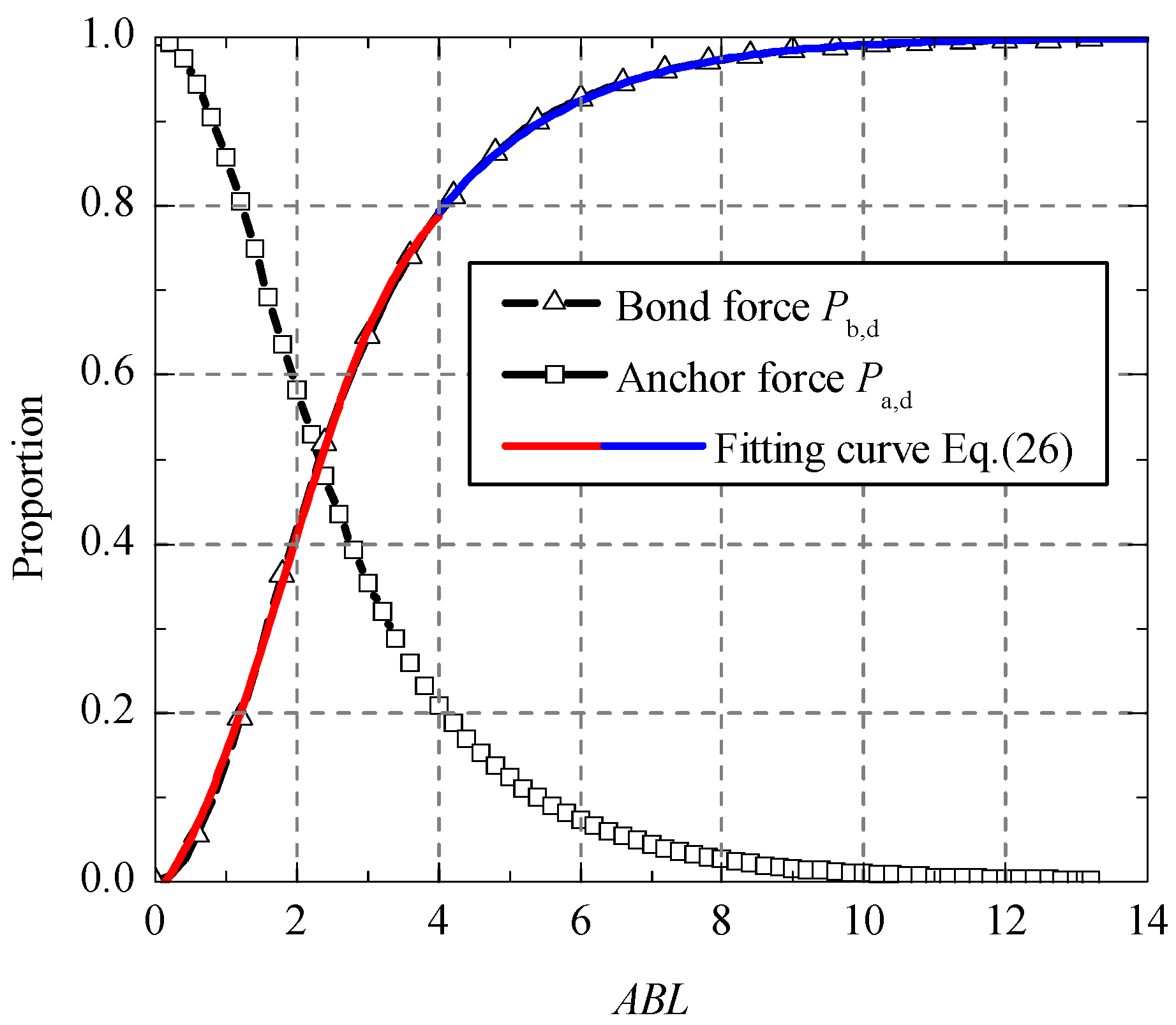
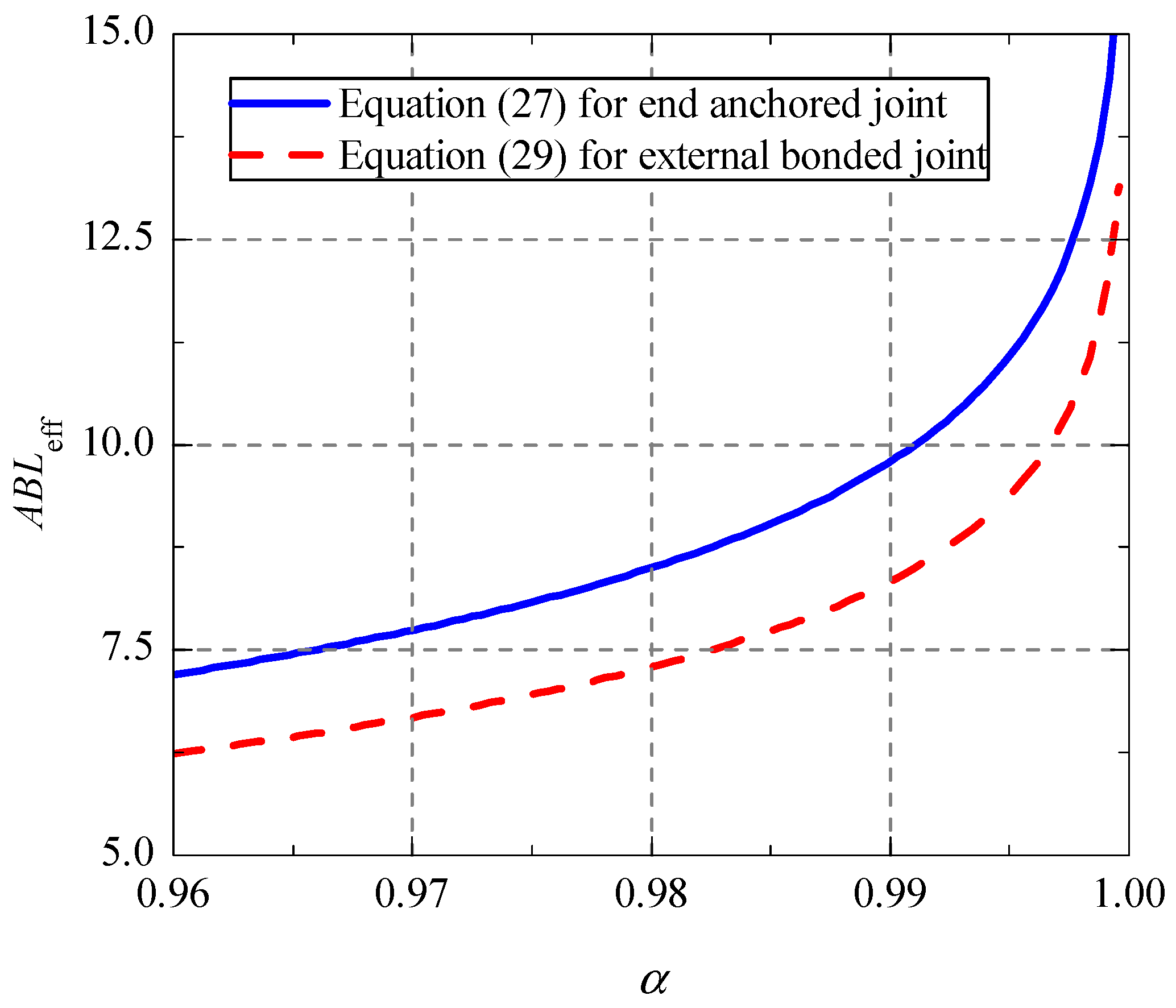
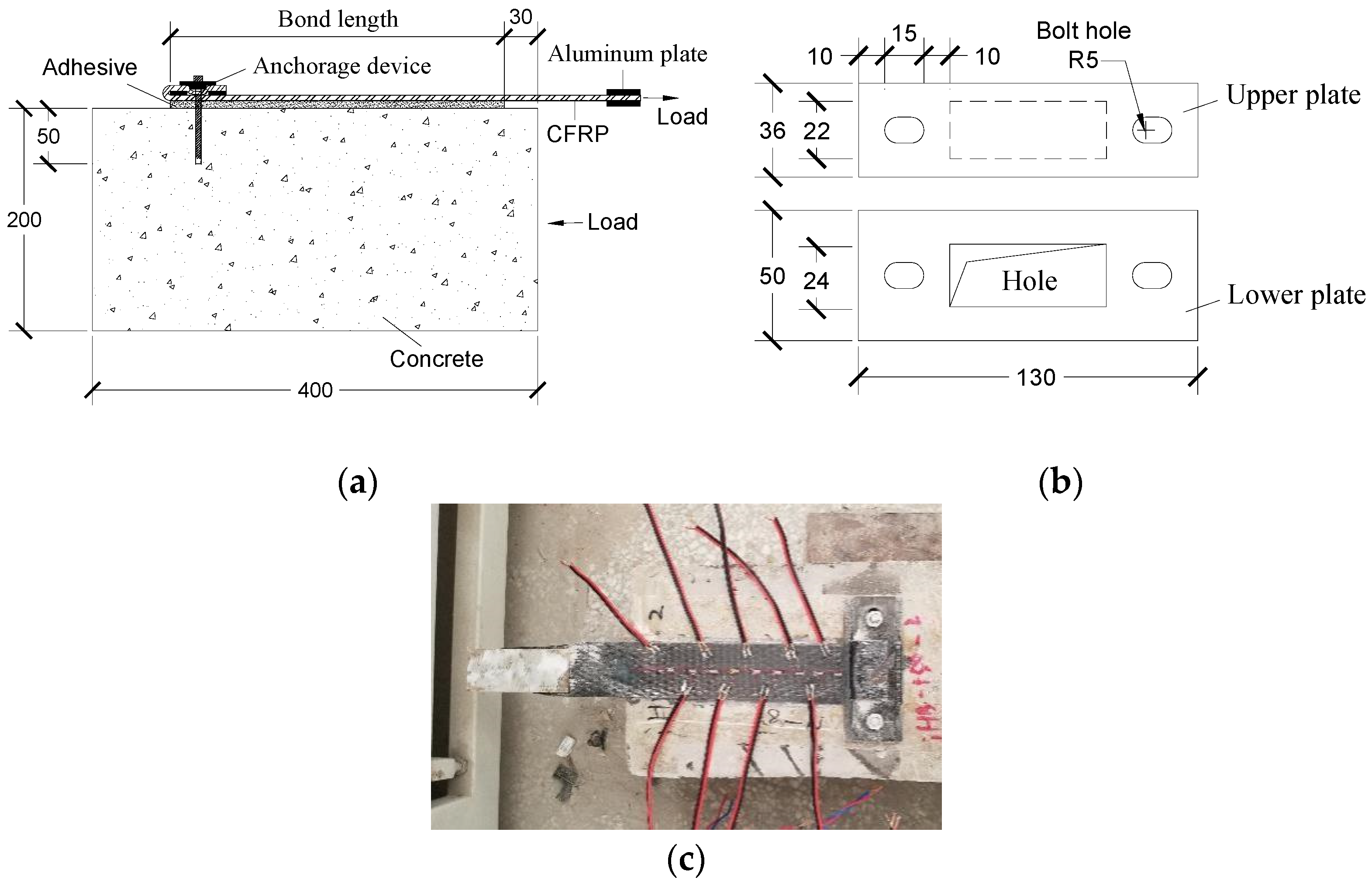

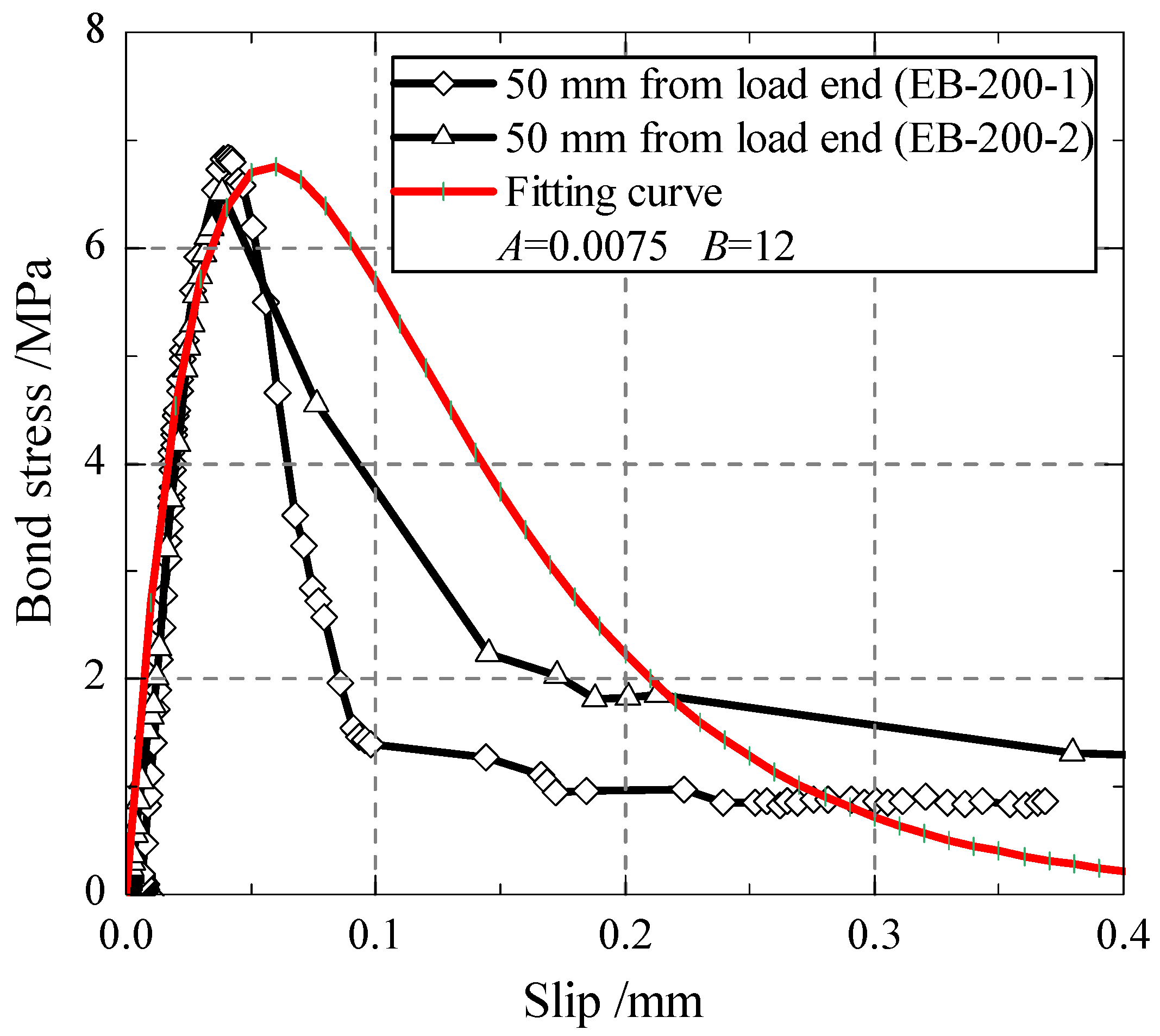

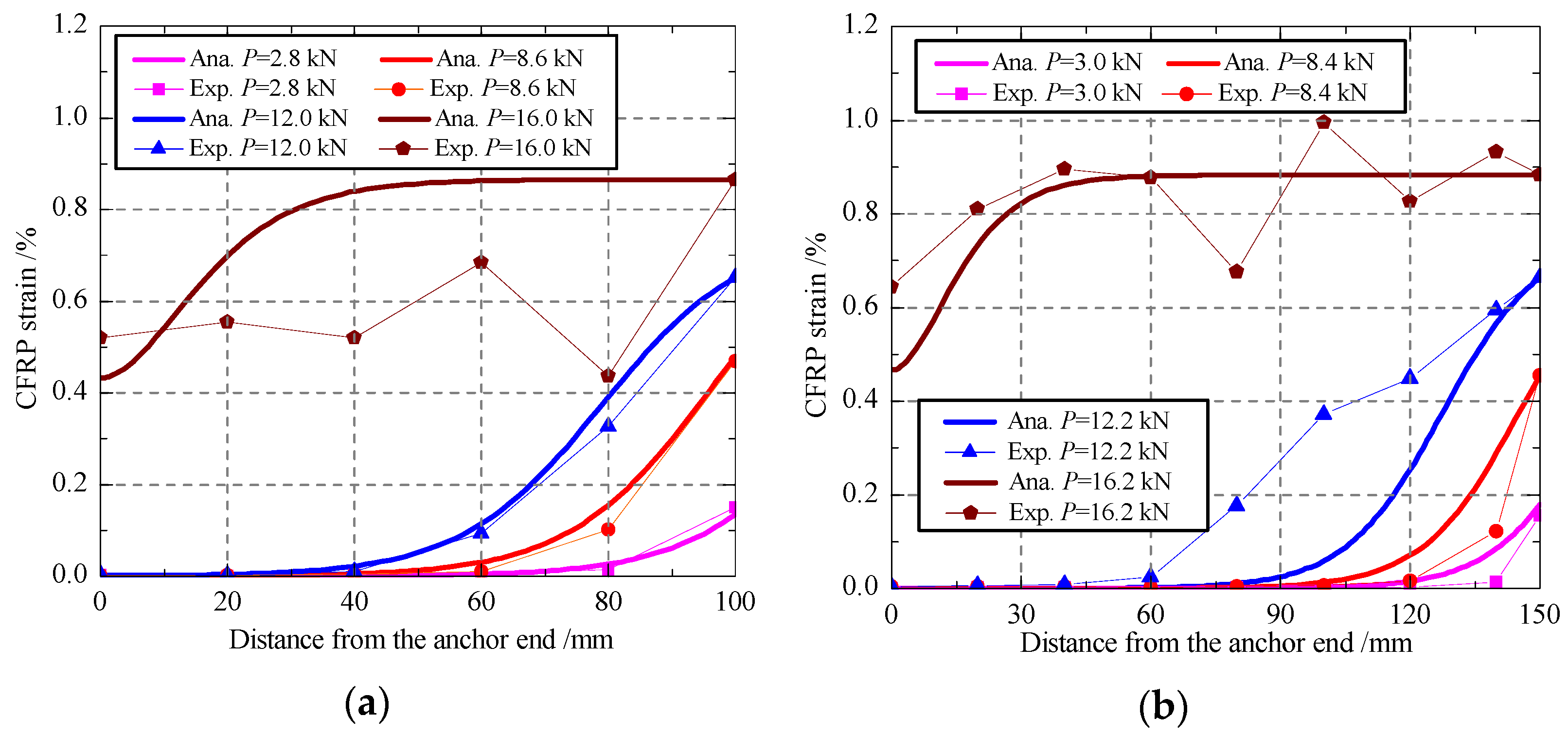
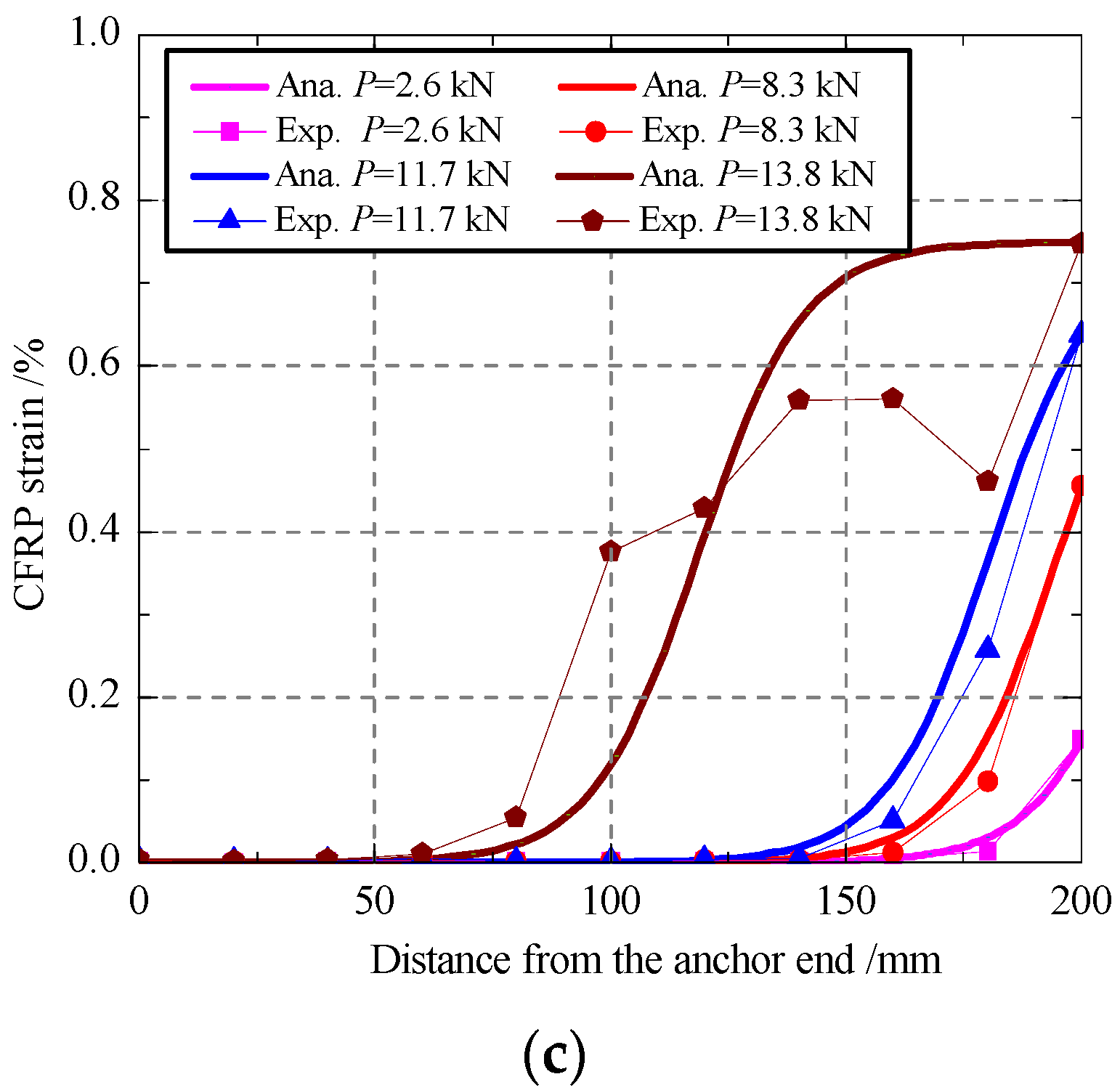
| Specimen Code | Bond Length (mm) | Bond Width (mm) | CFRP Thickness (mm) | Anchor Form |
|---|---|---|---|---|
| EB-200-1,2 | 200 | 50 | 0.167 | EB |
| EA-100-1,2 | 100 | EA | ||
| EA-150-1,2 | 150 | EA | ||
| EA-200-1,2 | 200 | EA |
| Specimen Code | Ultimate Load Pu/KN | Ultimate Slip su/mm | Failure Mode |
|---|---|---|---|
| EB-200-1,2 | 12.96 | 0.8355 | Debonding failure of Interface |
| EA-100-1,2 | 21.37 | 0.9466 | Fracture failure of CFRP |
| EA-150-1,2 | 20.54 | 1.4758 | Fracture failure of CFRP |
| EA-200-1,2 | 20.29 | 2.2557 | Fracture failure of CFRP |
| Specimens | Bond Failure Load Pd/kN | Bond Failure Slip sd/mm | ||||
|---|---|---|---|---|---|---|
| Exp. | Ana. | Ana./Exp. | Exp. | Ana. | Ana./Exp. | |
| EA-100-1,2 | -- | 13.57 | -- | -- | 0.3477 | -- |
| EA-150-1,2 | 12.98 | 13.75 | 1.06 | 0.4460 | 0.5088 | 1.14 |
| EA-200-1,2 | 12.83 | 13.75 | 1.07 | 0.5002 | 0.5080 | 1.02 |
Publisher’s Note: MDPI stays neutral with regard to jurisdictional claims in published maps and institutional affiliations. |
© 2021 by the authors. Licensee MDPI, Basel, Switzerland. This article is an open access article distributed under the terms and conditions of the Creative Commons Attribution (CC BY) license (https://creativecommons.org/licenses/by/4.0/).
Share and Cite
Dong, K.; Zhong, C.; Li, P.; Du, D. Analytical Model for Bond Behavior Prediction of CFRP-Concrete Joints with End Anchorage. Polymers 2021, 13, 3684. https://doi.org/10.3390/polym13213684
Dong K, Zhong C, Li P, Du D. Analytical Model for Bond Behavior Prediction of CFRP-Concrete Joints with End Anchorage. Polymers. 2021; 13(21):3684. https://doi.org/10.3390/polym13213684
Chicago/Turabian StyleDong, Kun, Caiqun Zhong, Peng Li, and Derun Du. 2021. "Analytical Model for Bond Behavior Prediction of CFRP-Concrete Joints with End Anchorage" Polymers 13, no. 21: 3684. https://doi.org/10.3390/polym13213684
APA StyleDong, K., Zhong, C., Li, P., & Du, D. (2021). Analytical Model for Bond Behavior Prediction of CFRP-Concrete Joints with End Anchorage. Polymers, 13(21), 3684. https://doi.org/10.3390/polym13213684







